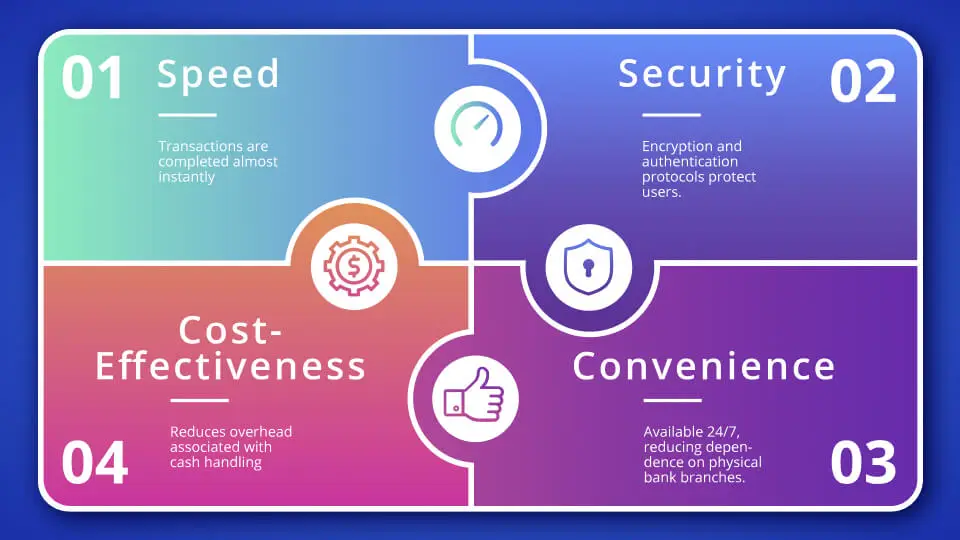The world is gradually moving toward digital transactions, and the Middle East and North Africa (MENA) region is no exception. Businesses, governments, and individuals across the region are increasingly embracing electronic payment systems, changing how commerce and daily life work.
From convenience and security to growth opportunities, this digital revolution comes with Digital Payments solutions tailored to the specific needs of the market. But how did digital payments evolve, and what impact do they have on the MENA region today?
Let’s explore the growing significance of digital payment systems.
What Are Digital Payments?
Digital payment, in short, is the transaction where money gets transferred in electronic mode between parties through an online or mobile platform.
This payment system puts an end to carrying cash or even checks, as it replaces them with digital wallets, debit and credit cards, or mobile applications.
Key Characteristics of Digital Payments:
- Speed: Transactions are completed almost instantly.
- Security: Encryption and authentication protocols protect users.
- Convenience: Available 24/7, reducing dependence on physical bank branches.
- Cost-Effectiveness: Reduces overhead associated with cash handling.
Evolution of Digital Payment in the Middle East
The MENA journey toward digital payments has been unique and dynamic. Traditionally reliant on cash-based transactions, the region has experienced remarkable growth in the adoption of digital payments over the past decade. Here’s how:
Early Stages
At the beginning of the 2000s, the MENA region had very few options for online payment. Cash-on-delivery dominated e-commerce, credit cards were few, and online payment gateways almost did not exist.
Transition Period
Starting in the mid-2010s, smartphones and mobile internet started to change consumer behavior.
While global platforms such as PayPal are entering the region, solutions more indigenous to specific contexts have cropped up: Fawry for Egypt, SADAD for Saudi Arabia, and Konnect for Tunisia.
Present Day
Today, fintech innovations and government initiatives have given a fillip to the growth in digital payments. This points out the imperative nature of such solutions when it comes to modern economies, like Saudi Arabia’s Vision 2030 and the UAE’s push to go cashless.
Contactless payments, QR code displays, and mobile wallets are a common sight across all markets.
The Role of Digital Payments in the MENA Region
Beyond just convenience, the realm of digital payments covers one of the very strong building blocks of economic and social development. Let us analyze a few key roles it plays in the region.
Driving Financial Inclusion
In countries where a big percentage of the population still stays unbanked, digital payment modes provide an entryway into the financial system.
In North Africa, for instance, mobile money systems, such as Orange Money, are allowing people without access to a bank account to carry out transactions.
Boosting E-commerce Growth
The e-commerce market in MENA will reach $49 billion by 2025, as per Statista. Digital payment solutions ease online shopping by providing fast and secure transactions that create trust among consumers.
Facilitating Cross-Border Trade
The MENA region has long been the most strategically positioned focal point for international trade. This made digital payment a crucial phase in the evolution of commerce.
The payment platforms made cross-border transactions a breeze, as it reduced both costs and time, which in turn benefitted both exporters and importers.
Improving Government Services
Governments are using such digital payment platforms to drive efficiency in service delivery utility bill payments to even collecting taxes. These systems cut down on bureaucratic tangles and bring transparency to the fore.
What are you waiting for? Elevate your business by embracing innovative digital payment solutions. Visit HKS Global Group today to discover how we can help you grow with secure and efficient payment systems tailored for the MENA market.
How Digital Payments Can Help Your Business
Whether it be small or large, incorporating digital payments into your operations promises several benefits including:
Speedy Transactions
Digital payments reduce the time taken for transactions compared to that of traditional methods, meaning businesses can handle more and more transactions in a short time.
Increased Customer Convenience
Having multiple payment options increases convenience for your customers: credit cards, mobile wallets, and QR codes. These can contribute to customer satisfaction and retention.
Cost Savings
Businesses save on labor and operational costs by automating the transaction process and reducing cash handling.
Enhanced Security
Advanced encryption and fraud detection technologies protect businesses and customers against financial loss in digital payment systems.
Access to Analytics
Digital payment platforms often offer a lot of insight into customer behavior, which aids in refining marketing and sales strategies.
What To Consider When Choosing a Digital Payment Service Provider
Selecting the right digital payment provider is crucial for ensuring seamless operations and customer satisfaction. Here are key factors to evaluate:
Compatibility with Local Markets
Ensure the provider supports localized payment methods and complies with regional regulations. For instance, a provider that facilitates payments in local currencies will likely gain more traction.
Transaction Fees
Compare various service providers’ fees that pertain to setup, transactions, and withdrawals. The least-cost alternative will directly impact profitability.
Security
Only consider those service providers offering added security features such as 2FA, data encryption, and fraud mitigation methods.
Usability
Ease of usage — a user-friendly portal. Make sure the solution provider allows the software to integrate seamlessly into an existing system.
Customer support
Reliable customer support, especially in resolving issues quickly to maintain smooth operations, is crucial.
Conclusion
The increasing usage of digital payments in the MENA region presages a new epoch in corporate and personal financial dealings. From expanding financial inclusion to increasing growth in e-commerce, these are only some of the wide-ranging benefits.
However, it creates many challenges, including the right choice of a digital payment service provider and the effective integration of these systems to realize the potential fully.
As the region increasingly opens its arms to digitization, it will see localized payment solutions at the forefront of this exciting change.
FAQs
What is the role of the electronic payment system?
Electronic payment systems enable cashless transactions, saving time and reducing costs. Different types of electronic payments cater to various needs, from card payments to digital wallets.
The process involves entering payment information, validation, security, and transaction processing.
Which country is top in digital payment?
India lists amongst the world’s top 10 countries for digital payments as it boasts a number of apps that perform well in terms of digital payments.
Does Egypt allow PayPal?
Yes, PayPal does operate in Egypt and even has a dedicated website for its customers there. PayPal offers accounts and services for both personal customers and businesses.
How popular is digital payment?
Digital payments have become increasingly important in India in recent years, as the country has seen a rapid increase in the adoption of smartphones and internet access.
Maria
I'm a Fintech & Digital Distribution Writer. I do create engaging content on B2B solutions, gift cards, eSIMs, and prepaid services and more. I provide tailor-made solutions that empower businesses and consumers.





